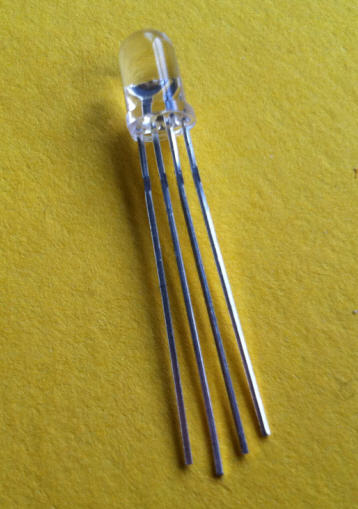
The Care and Feeding of My Pet Arduino
by Budd Churchward - WB7FHC - NIBBLES AND BITS LIBRARY
Sequencing RGB LEDs
« 1 2 3 4 5 6 »

|
Nibbles and Bits
The Care and Feeding of My Pet Arduino by Budd Churchward - WB7FHC - NIBBLES AND BITS LIBRARY Sequencing RGB LEDs« 1 2 3 4 5 6 » |
Section 5 - Writing the Sketch
|
Here is the complete sketch, fully documented, that you can copy and paste
into your project. It is ready to run. To help you understand how
and why it works, I will discribe the parts of the sketch below.
We start by declaring all of our variables. We use these to designate the OUTPUT pins from Arduino. I have chosen the sequence: 5 6 7 so that I can do simple arthmetic with the next variable:
int red=5;
int green=6;
int blue=7;
This variable, 'color', will change each time we press the button. It starts out as '7' which is the value we have assigned to the color 'blue'. We will increment the value of 'color' each time the button is pressed.
int color=blue;
Here we have declared 'button' as '11'. This is the pin we will use to read the INPUT from our switch. We also have declared 'val' where we will store the value we read from pin 11.
int button=11;
int val=0;
'didThis' is a Boolean variable that will be either TRUE or FALSE. When Arduino runs a sketch, he loops through our code over and over quite quickly. We have code that we want him to follow only once each time we press the button. We will use 'didThis' to tell him that he doesn't need to do something that he has already done.
boolean didThis=false;
Declare our OUTPUT and INPUT pins:
void setup()
This is where Arduino chases his tail.
While he is spinning around here, we have him check our button:
val=digitalRead(button);
and then jump out of the loop and do one of two things:
lightMyFire();
- or -
alloff();
This is where we turn on the LED:
void lightMyFire() {
First we check to see if we have already done this. If we have we return back to loop
if (didThis) return;
We make 'color' one higher. If it is higher than our top color, knock it back down to our bottom color.
color++;
if (color>blue) color=red;
Turn on the our current color pin to light the LED
digitalWrite(color,1);
Now we set this value so we don't do this again.
didThis=true;
Here is where we turn the LED off. We are turning all of the colors off even though only one is on. The sketch is set up so you can experiment with the code to create different effects.
void allOff() {
digitalWrite(red,0);
digitalWrite(green,0);
digitalWrite(blue,0);
And finally, we flip our Boolean value so we can do it all again the next time the button is pressed.
didThis=false;
In the final section we have a video that demonstrates this project. |
|